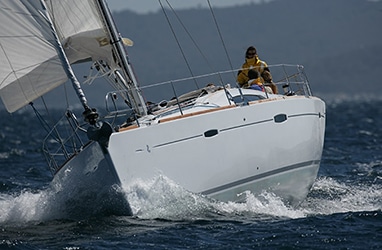
This article is an excerpt from NauticEd’s online FREE Navigation Rules Course, an interactive online sailing course for ALL sailors to learn Navigation Rules and become a safer sailor. Or if you want to learn more, upgrade to the Skipper Course Bundle to become a competent sailor!
You can learn to sail and improve your sailing with NauticEd, the international leader in sailing education.
Responsibility between Vessels Nav Rules
Every vessel has a definition of being one and only one of the below at all times. And each vessel has the ability to morph from one to the other. A fishing vessel may haul in its nets. A sailboat may turn on its engines. A container ship may move from the open ocean into a narrow channel. Thus, you have the responsibility of determining what is the vessel definition whereby you have a collision potential and you will take actions accordingly and know what status you have – Stand-On or Give-Way.
Overtaken: Vessels being overtaken are the Stand-on vessel. No matter what type you are, if you are overtaking another vessel, you must Give-Way to that vessel.
Not under command: This means vessels that may somehow be disabled due to extraordinary circumstances such as mechanical means or if the crew is out of action. This is certainly a very unusual case and not very likely to happen but the rules put this case at the top of the order of Stand-On vessels. I.E. It means that if a boat is moving or drifting and not able to control itself then you should Give Way to it. Durh!
Restricted in its ability to maneuver: This usually refers to large commercial vessels in shipping lanes, barges, or vessels engaged in towing, drilling, or dredging. Well durh again – of course this makes sense.
Constrained by Draft: This refers to vessels that are in channels, rivers etc., and causing them to maneuver out of your way would possibly cause them to run aground. Durh of course!
Fishing vessels engaged in fishing: The term “vessel engaged in fishing” means any vessel fishing with nets, lines, trawls, or other fishing apparatus which restrict maneuverability, but does not include a vessel fishing with trolling lines or other fishing apparatus which do not restrict manageability.
(Note as a fisherman AND a sailor – I employ a little courtesy here as well i.e. if someone is trolling, why not tack away early with a smile and a wave?)
Sailing Vessels underway: The term “sailing vessel” means any vessel under sail provided that propelling machinery, if fitted, is not being used.
Power-driven vessels: The term ‘power-driven vessel’ means any vessel propelled by machinery. i.e. These are power-driven vessels that do not fall into any of the categories above.
Seaplanes: Strange one – but they have to come somewhere. Now of course a plane that is making an emergency water landing is classified as a Vessel not under command. Better get out of its way!
WIG craft: This is a relatively new category. They are essentially seaplanes but fly near the surface of the water using the lift from the ground effect phenomenon.
The above is the internationally recognized pecking order of who is the Stand-on vessel over the vessel below it. e.g. fishing vessels engaged in fishing are the Stand-On vessel over sailboats.
Please ignore and forget the ill-informed statement made by anyone at the yacht club that sailboats have the right of way over everyone else. THEY ARE WRONG.
The pecking order of who is to Give-Way to who is logically defined from a vessel’s ability to get out of the way of another. And since sailboats are quite maneuverable they are actually quite a way down the pecking order of who is the Stand-On vessel.
The Mnemonic that most people use to remember the order is this:
Only New Reels Catch Fish So Purchase Some.
O – Overtaken
N – Not Under Command
R – Restricted in ability to Maneuver
C – Constrained by Draft
F – Fishing with restricted maneuverability
S – Sailboats
P – Power-driven vessels
S – Seaplanes
Learn Navigation Rules for Free...
A FREE 3-hour course that teaches how to stay safe, avoid collisions and accidents, and learn the “Rules of the Road”. The free Navigation Rules Course is for ALL sailors, whether you’re just learning or need a FREE refresher. Or, consider upgrading to the Skipper Course Bundle to become a fully competent skipper!
